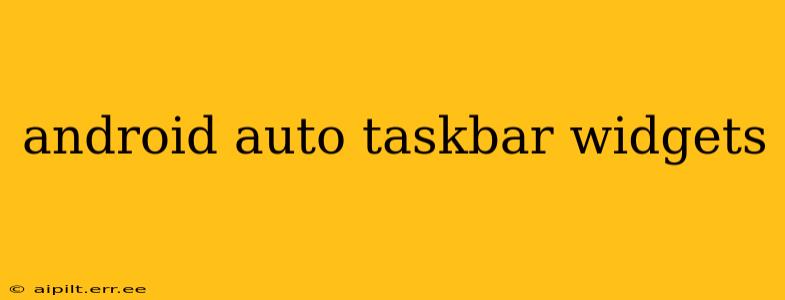Android Auto has revolutionized the in-car experience, providing a safer and more convenient way to use your phone's features while driving. While the core functionality focuses on navigation, communication, and media playback, many drivers are curious about expanding its capabilities with widgets and a more customizable taskbar. This article explores the current state of Android Auto widgets and taskbars, addressing common questions and looking towards the future of in-car customization.
Can I Add Widgets to My Android Auto Screen?
Currently, the answer is no. Android Auto doesn't directly support the addition of third-party widgets to its main interface in the same way your Android phone's home screen does. The system prioritizes a clean, minimal interface to reduce distractions while driving. The core apps and functions are carefully selected to minimize visual clutter and cognitive load.
Are There Any Taskbar Customization Options in Android Auto?
Similar to widgets, direct taskbar customization options are limited within the standard Android Auto experience. Google designs the interface with safety in mind, restricting options that could potentially lead to driver distraction. The core functionality is primarily focused on providing essential features—navigation, communication, and media—in a streamlined and easy-to-use format. There's no built-in setting to add or remove specific icons from the bottom taskbar.
What Features are Available on the Android Auto Taskbar?
The Android Auto taskbar generally includes icons for core functionalities:
- Navigation: Access to your active navigation app (Google Maps, Waze, etc.).
- Phone: Quick access to your recent calls, contacts, and the ability to initiate a new call.
- Messaging: Access to compatible messaging apps for reading and sending messages (usually via voice commands).
- Media: Control your music playback (Spotify, YouTube Music, etc.).
These icons are consistent across different Android Auto implementations, focusing on the most crucial driving-related features.
How Can I Improve My Android Auto Experience?
While direct widget or taskbar customization isn't available, there are ways to optimize your Android Auto experience:
- Choose compatible apps: Ensure your preferred navigation, communication, and media apps are compatible with Android Auto for seamless integration.
- Use voice commands: Android Auto is heavily reliant on voice commands, allowing you to interact with your phone without taking your hands off the wheel. Mastering these commands can greatly enhance the overall experience.
- Organize your phone: Keeping your phone's apps and contacts organized will make it easier to access information through Android Auto's voice commands or limited interface.
- Keep your software updated: Staying up-to-date with Android Auto and your phone's operating system ensures you have access to the latest features and bug fixes.
Will Android Auto Ever Support Widgets and Taskbar Customization?
The possibility of future updates offering greater customization remains open. However, any such changes would need to prioritize safety and avoid introducing distractions that could compromise driver focus. Google carefully balances functionality with safety concerns when designing the Android Auto interface. While extensive customization is currently absent, future iterations might include carefully curated options that enhance functionality without sacrificing safety.
Conclusion
While Android Auto currently doesn't offer the flexibility of widgets or extensive taskbar customization, its core functionality is designed to be safe and efficient for drivers. By mastering voice commands and choosing compatible apps, you can significantly enhance your driving experience. The future may hold some degree of increased personalization, but safety will undoubtedly remain the primary design principle.
